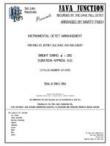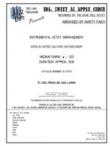WHEN THE SAINTS GO MARCHING IN [DOWNLOAD]
Recorded by the Dave Pell Octet
Arranged by Marty Paich, Prepared for Publication by Dylan Canterbury, Rob DuBoff, and Jeffrey Sultanof

Cat #: JLP-8644-DL
$40.00This product is available for immediate download after purchase.
Questions?
Please call +1-518-587-1102 or email us.
Edition: Jazz Octet Arrangement
Description: Swing - Medium
Publisher: Jazz Lines Publications
When the Saints Go Marching In is widely known as a Dixieland classic. Marty Paich's arrangement for the Dave Pell Octet does a good job of maintaining a New Orleans-style call-and-response feel while throwing in some new tricks to give it a gentle, cool-jazz update. This was released on the 1961 Capital album The Old South Wails!
The melody is stated twice at the beginning, starting with the tenor sax and trumpet issuing the call to the rest of the band's response. The time becomes more straight-ahead at measure 9, where the trumpet and tenor are now backed up by a simple counter line in the baritone sax and trombone. The rhythm section start off the second statement of the melody at measure 17 underneath the horns, whose winding counterpoint eventually snatches the melody back at measure 17.
A lengthy breakdown begins at measure 33, with the horns continuing their split into groups of trumpet-tenor and baritone-trombone. The rhythm section gently prods everything along with a series of amen-like exertions, occasionally joined by the horns along the way. The horn counterpoint begins to ramp up more at measure 47, including a nod to a signature lick from trumpeter Harry "Sweets" Edison.
A quick fanfare marks a key change at measure 53. This new section is largely dominated by solos, starting with tenor sax, followed by trumpet, and finally baritone sax. The band returns to the original key for a shout chorus at measure 86 that takes more than a few cues from the sound of the Count Basie Orchestra. A piano chorus at measure 102 eventually brings the melody back in, which is played exactly the same way as it was at the beginning. For an ending, the original recording features a vamp and fade over measures 150-159, however an optional gospel-inspired amen is written into the chart if you would like to have a more defined conclusion in your own performance.
This publication was based on the original parts used during the recording session, supplied to us by Dave Pell - this is not a transcription.
Tenor Saxophone
Baritone Saxophone
Trumpet
Trombone
Piano
Bass
Drums
Guitar
Trombone: F4










